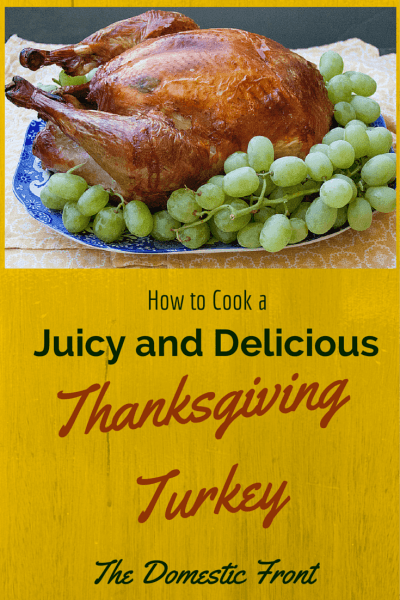
Do you want your Thanksgiving turkey to be the star of the show rather than a dry disappointment? Do you want to learn how to brine a turkey without wrestling with giant tubs of salt water and worrying about giving your guests salmonella? Do you want a Thanksgiving turkey that tastes like turkey, even with a frozen bird? Read on. I’ve got the solution for you.
Hosting Thanksgiving dinner can be awfully anxiety producing. First, there’s the worry about seating logistics – is your table big enough for your number of guests? Do you have enough chairs? (Here’s a tip — don’t seat anyone who has graduated from high school at the kid’s table). Then there’s the anxiety about what to serve — Uncle Jim insists on green bean casserole but Cousin Imogen hates mushrooms. Your husband always had mashed potatoes when he was growing up, your brother prefers roasted potatoes and your great aunt Cassie (who isn’t really your aunt but everyone calls her aunt anyway because she went to summer camp with your grandfather’s sister) thinks potatoes have no place on the table, only parsnips. But nothing creates as much anxiety as the traditional centerpiece of the Thanksgiving table: the turkey.
When I was a kid, nobody really liked turkey. I remember many Thanksgivings of tasteless Butterball birds, on the dry side, that you dressed up with fancy cranberry sauce and politely choked down a slice before digging into the bread stuffing. When I started hosting my own Thanksgiving dinners, I, armed with this newfangled thing called the internet, set out to make a delicious, juicy turkey that would be a pleasure to eat — a true centerpiece. I read all of the literature — I tried flipping the bird halfway through cooking (have you ever tried flipping a hot turkey? No fun), Tenting it with foil (the bird was very juicy — so juicy it fell apart in the oven and couldn’t be carved), lathering it with butter (great, crispy skin, but the meat was still decidely blah) and finally the current conventional wisdom, a wet brine, which involves immersing the turkey in a salt water bath for a few days prior to roasting, assuming that the water will seep deep into the turkey’s core. The wet brining was quite a daunting proposition — finding a tub big enough to hold a turkey and the brine, finding a place to put it in the refrigerator (because you don’t want to leave a turkey brining at room temperature), and then roasting it only to discover that the turkey was juicy and flavorful, but the brine really cured the turkey, giving it a slightly watery texture and a flavor closer to ham than the roast turkey of my dreams.
How to Brine a Turkey
Luckily for you all, though, I have discovered the secret to how to brine a turkey to yield a flavorful, juicy and EASY turkey, and it doesn’t require an industrial walk in refrigerator — the dry brine. I learned about the dry brine from Judy Rodgers in the fantastic Zuni Cafe Cookbook. A dry brine — which involves salting the meat well in advance of cooking, which first draws the juices out of the turkey due to osmosis, then draws the seasoned juices back in — is the secret to my favorite roast chicken recipe, served at the Zuni Cafe in San Francisco. I reasoned — if the method delivers a delicious, juicy, flavorful roast chicken, then why shouldn’t it work on turkey?
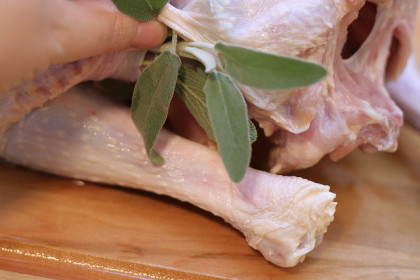
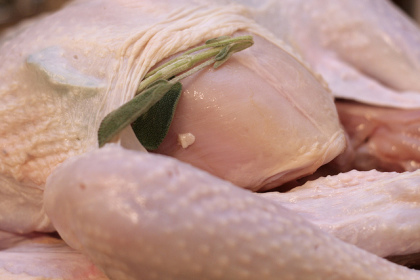
And it does — the skin is gloriously crisp, the meat is firm but not dry, and every bite is seasoned, not bland. Best of all, it tastes like turkey, not like ham, not like some proprietary blend of spices you can get at Crate and Barrel or from Alton Brown, but like roast turkey the way you always suspected it should taste, but it never did. This works fantastically on an organic, free range heritage bird, but it will also yield a lovely, juicy turkey from your grocery store’s freezer.
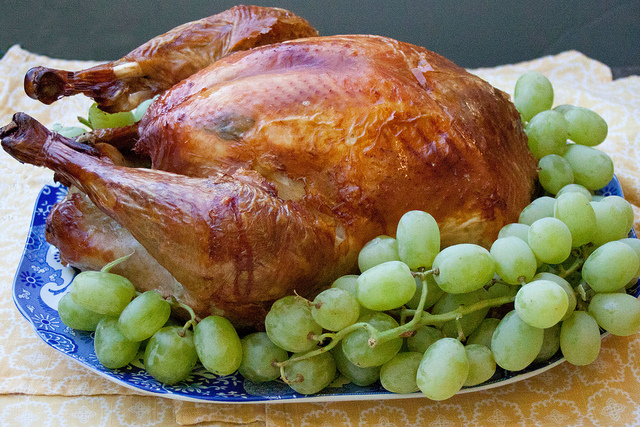
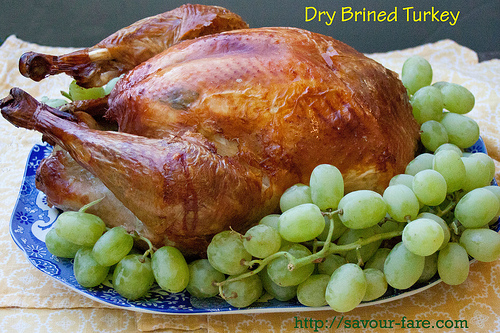
- 1 8-12 lb turkey
- Fresh Sage
- Kosher Salt
- To prepare this turkey, 2-3 days before Thanksgiving, make sure your turkey is defrosted, if you're using a frozen one, and remove the giblets. Rinse and pat dry, both inside and out. Fold the wings under the body. Then use your fingers to create pockets between the skin and the meat on the breast and the thighs. Take sprigs of fresh sage and insert them into the pockets (this is optional, but I think sage is wonderful with turkey and is one of the quintessential Thanksgiving flavors).
- Then you take kosher salt and rub it into the turkey. Start with about 1 T of salt per every five pounds of turkey, but you can use more, particularly if you like things a little salty and you're not stuffing the turkey. I rub it into the underside first, then turn the turkey over and rub it into the breast side. Place the turkey on a cookie sheet (since there is some juice runoff, a sheet with a lip works best) and loosely tent with foil (you want good airflow). Then refrigerate for 2-3 days. (A 10 lb turkey was perfectly brined in just 2 days. A larger turkey might take 3. If you're reading this and it's the day before Thanksgiving, do it now. Just know that it won't be quite as delicious).
- When you're ready to roast the turkey, preheat the oven to 450. It's nice but not necessary to let the turkey come to room temperature. I tied the drumsticks together with kitchen twine because I think it makes a nicer table presentation, but it's not necessary. Then place the turkey in your roasting pan, and roast. An unstuffed turkey at 450 degrees will take about 8 minutes a pound, but the best way to measure is to have a thermometer in the thigh reach 160 degrees. I have a thermometer similar to this one that stays in the turkey during roasting and beeps when it reaches the preset temperature. This 10 lb turkey took about an hour and 20 minutes. (The USDA recommends 180 degrees, but salmonella is dead after 30 seconds at 160 degrees, and 180 is WAY overcooked.) (Note that this is for an unstuffed turkey. There are different rules about stuffing, which should be cooked to 160 degrees, which means the turkey will most likely be overdone).


Great idea. I’ve never tried a dry brine on turkey — but it makes a great deal of sense. Perfect with those bacon braised brussels sprouts, I’d imagine!
Ever since I tried the Zuni roast chicken technique, I just can’t go back. Have not even thought about doing it with turkey. Forwarding this to my mom 🙂
A fantastic technique- would this be something you would mind sharing with the Foodista community?
lo — Bacon braised brussels sprouts are always a good idea!
Kasey — I keep trying other roast chicken recipes, but nothing beats Zuni!
Melissa — I’d be happy to share with the foodista community!
Wow Kate, I am SO happy you posted this! Looks like my father won’t be up for cooking the turkey this year, so for the first time ever, the bird is up to me. I am definitely going to try this.
That Judy Rogers…If she had a dime for every dry brined turkey she’d be a millionaire! That’s exactly how I’m going to do my turkey too. I was wondering if I could do the old herbs-under-the-skin trick… Good to know it worked for you. Thanks for the post!
Thank you for much for taking the time to make this recipe and post it before Thanksgiving! I’m excited to give it a try!
I can’t wait to try a dry brined turkey this year! Love the addition of the sage, you’re right, it is a quintessential Thanksgiving (and Fall) flavor. I can taste it already!
i think i’m going to try that this year! i did alton brown’s wet brine last year and it was good but this seems so much easier!
Have I mentioned lately how much I love your blog? I have a big package of Williams Sonoma brine mix and this sounds so much more appealing than trying to stuff a wet 16 pound bag of salmonella liquid in the fridge for a day.
This is absolutely the best way to cook a turkey. I couldn’t agree more! We do a very similar bird, stuffing lemon slices and butter underneath the skin along with the sage.
I make the Zuni Roast Chicken all the time too and have been planning to try it on my turkey too so I am glad to see it was a success.
I guess you didn’t do the flip thing Judy Rodgers recommends with the chicken.
I have a 12-pound free-range fresh turkey – it was the smallest bird I could find. Since I’m cooking for two, I may make the Zuni Bread Salad instead of stuffing. The currants and pine nuts sound delicious with a turkey dinner!
Thank you for the post, I am looking forward to Thanksgiving to try this out. I have been making the Zuni Roast Chicken and I was curious on how I could do it on a turkey.
I can’t wait to try this on a chicken AND our Thanksgiving turkey! This is my first year roasting a whole turkey and the logistics of this in the fridge will be so much easier than a wet brine.
should I cover it with foil for the first hour or so?
Breasts up or breasts down?
I’ve got the breasts up
Susan, I don’t tent with foil, (I find the turkey steams, and the skin never recovers) but if you try it, please report back.
Eric — breasts up. Nothing looks sadder on Thanksgiving than bringing a big bird to the table with squashed breasts.
Thanks Kate!
So you don’t cover it at all?
(this is my first time making a turkey…doing it today!)
LOL….Kate…we wouldn’t want to have squashed breasts at the dinner table.
@Eric: or elsewhere…
Okay…I cooked it to 170 and took it out to cool.
The juices ran clear from the breast.
HOWEVER…when I pulled it up to move it onto the carving board, all this dark pink juice poured out of the cavity. Does this mean it goes back in?
Oh man…
Do you put any aromatics in the cavity of the bird?
What exactly do you do with the wings?
Susan — Was it 165 in the thighs/dark meat?
I think so…
I put it back in…yikes, hope I haven’t ruined it!
OK, Susan, I did some googling, and if all the meat reads at 165 (the minimum safe temperature) then it’s OK to eat, even if the juices are pink. What Butterball said:
is not unusual to see clear pink juices inside the turkey, especially when roasted unstuffed. Frozen turkeys (with added basting) tend to have more juices and if the turkey was not completely thawed a greater amount of liquid could accumulate in the cavity.
Butterball turkeys are young turkeys and the bones are not completely hardened. The bone marrow contains the pigment (myoglobin) that colors blood. As the turkey cooks, this pigment can accumulate into the juices of the turkey collecting in the body cavity or next to the bone. This is more likely with fast cook methods (e.g. oven cooking bag and convection oven) due to incomplete denaturation of the myoglobin during the shorter cook time. Juices in the cavity should be at least 165 degrees F when the turkey is done.
NOTE: Use a meat thermometer to determine turkey doneness — especially important with fast cook methods such as convection oven or “oven cooking bag” and for very large turkeys where thigh may be done before stuffing or breast. When done, the turkey thigh (joint where thigh joins carcass) should register 180-185 degrees F., thickest part of breast 170 -175 degrees F. and center of stuffing 165 degrees F.
Wow Kate – you are the best!
I did put it back in for just a bit…it’s a fresh one. Now my timing is all wrong – I have to leave to go get kids from schools…about an hour. Going to leave it in a warm oven and hope for the best.
Or can I just leave it out to cool while I’m gone?
yikes.
Thanks so much for taking the time to answer my questions! 🙂
It turned out great!
Thank you so much for developing and posting this recipe! I can’t wait to try it. I’m going to use it for roast chicken which I love, but which is sometimes a little bland. Great instructions!
Hi there!
A little late, but I wanted to thank you for all your Thanksgiving help – the turkey turned out GREAT! I actually covered it for about 30 minutes and then just turned it down to 325 so I could leave for close to an hour. WHEW…absolutely delicious.
Covering it did ruin a crispy skin, but that saved us from the temptation of eating it all anyway, so it’ s okay.
next year my goal will be to make sure I do not have to leave the house while it is cooking!
Happy Holidays to you!
I’m trying this technique for our turkey this year. 🙂 Some recipes I’ve read say to rinse the turkey after brining before roasting. Did/do you rinse yours? Thanks!
Hi Tracy. I actually recommend against rinsing. By the time the salt has worked it’s magic, there’s no more grains of salt left on the skin, and a drier skin is crispier, so rinsing would hurt that. If you’re judicious in your use of salt to begin with, it shouldn’t be too salty.
This sounds great and I am definitely trying it (its my first time cooking the infamous Thanksgiving turkey). Do you leave the sage leaves in it when you cook it and after? Do you have any links or recommend any gravy recipes? My mother in law insist I make their family recipe but it requires cooking the turkey in a bag to get the juices and I’m not about to give up my first time cooking a turkey to a broil in a bag!
Gina, I leave the sage leaves in to flavor the bird. You can take them out when you carve it. As for gravy, I’d recommend buying a couple of turkey wings, browning them, and making a stock from the wings to make your gravy. Saveur Magazine had a great recommended method on their website. My mother is the gravy queen in our family — I bow to her expertise and never attempt it myself!
Hi Kate,
I think I am going to try this and will be picking up a fresh bird in the morning. I typically use butter under the skin and also paprika on the bird, can I do this with the dry-brine? Can I put the butter on ahead of time or just do this before I put in the oven. Thanks!
Hi Kate,
typed my question incorrectly, meant is it okay to put butter under the skin right before I put into oven – after the dry brine completed. Do I need to rinse and pat again before putting butter ( assume use unsalted) under the skin. Thanks.
just put my 24 lb into the oven, unstuffed, thinking it will take 3 hours. audience concern is that the skin will char and the turkey will be dried out. of course, I’ll watch it but just confirming the oven does not get turned down anytime in this process? and I don’t need to cover it? experienced guidance would be appreciated.
I’ve always used Alton’s recipe for brining, but I’m convinced that I should try dry brining this year. I have one question though. I really want to use Epicurous’ Pancetta-Sage Butter rub http://www.epicurious.com/recipes/food/views/Pancetta-Sage-Turkey-with-Pancetta-Sage-Gravy-240379, and this recipe doesn’t call from brining at all. I’m concerned that if I wait to add the butter rub until after the dry brining that I’ll tear the skin. I’m assuming it’s not okay to add the rub 3 days before because every recipe I’ve seen adds the butter right before roasting. Any thoughts?
Leslie, in my experience the skin isn’t so fragile that you can’t put butter under the skin after dry brining. I’d loosen the skin prior to salting, and then slide in the butter before roasting.
Thank you SO much.
If I only have 24 hours, is it too late to try this? Will the turkey be too dry with less than 2-3 days for the brine to work? Thanks.
Constance,
It’s not too late to try it! It also cooks relatively quickly, so it’s not like you have to get it in the oven at 8 am on Thursday.
I only brined my 24 lb last year for a little over 24 hours and it was terrific, this year it has been going since Monday night! still concerned about cooking length. but will figure on 4 hours, last year it only took 3
Hi Kate,
Like others, I have used the Alton Brown wet brine recipe with much success. Instead of roasting my turkey in an oven, I grill it using my rotisserie, which always results in a very moist turkey. Have you ever tried grilling after the dry brine? I wasnt sure if the drier skin may be an issue and possibly char. I typically use a 10-11 pound turkey and grill it about 11 minutes/pound.
Will my gravy be salty after bringing?
Debby,
I haven’t found the gravy to be too salty. That said, I like to buy turkey wings and roast them and make the gravy in advance to save last minute prep. If you’re concerned about salt levels, that’s a great alternative.
Can the Dry-brine; put on a Frozen Turkey?
If so when the time come to roast it, you say not to rinse it. But I need to
rinse the inside.
Also, Plan to use the Nesco Roaster?
Any suggestions, Thanks!!!(ll-25-13).
Lois
Can the Dry-brine be used on Frozen Turkey?
I rinsed the Outside, but could not do the Inside?
You say not to Rinse, but I need to rinse the Inside. And, I will be using
a Nesco Roaster. So, will Blotting be enough, on the Breast area.
Any suggestions, Thanks.
Lois
Lois, you can absolutely dry brine a frozen turkey – in fact, the brining and defrosting can happen simultaneously – so efficient! There’s no need to rinse the turkey at all — many food safety experts are now recommending that you don’t – http://www.foodsafetynews.com/2011/11/do-not-rinse-your-turkey/#.UpTfwNKxeAk I have used paper towels to blot the inside, though. I’m unfamiliar with a Nesco roaster.
Sorry; but another question, Should I rub Mr. Turkey, down with Melted butter?
This is kind of scary, not ever doing it before…
I mixed a little Poultry seasoning with the Salt, so hope it was ok.
Thanks again for any suggestions.
Lois
Kate, The Turkey, after the Brine, should I put melted butter on the it.
Nesco Roaster, is what I will be using.
Any suggestion.
Thanks,
Lois
I don’t use butter because the drying time in the fridge makes the turkey super crisp. If you want butter, I’d rub it under the skin.
Happy Thanksgiving Kate
I have the 12lb, little over Turkey. Your saying your method is shorter cooking time.
Butterball, which I have, say’s to cook it 3hr or 180 deg.
If I cook it, (Nesco Roaster), can I keep it warm if I cook it to the 165 deg.
Kind of Scary, with Company coming.
Thanks,
Lois
Lois, the CDC is now say 165 is a safe internal temperature, and this will be moister than 180. http://www.cdc.gov/features/turkeytime/
I wouldn’t worry about keeping it warm. Just serve it closer to room temp but with hot gravy.
Kate, Thanks for all the Replies…
My Turkey, turned out so good…(yeah) was a little scared.
It was so moist, the Nesco Roaster does not Brown like the Oven, but I will always do
this for my Turkeys.
So glad I found your site; you have a few more recipes I want to try.
Thanks again,
Lois
I was really scared of this recipe as it was a huge “break away ” from the traditional methed of cooking turkey low and slow…and having a huge group for dinner was a giant risk…but one I’m thrilled I took!! Truly the best turkey I’ve ever eaten!!! Raves from my guests!! Followed to the letter…it was perfection. I will NEVER lose this recipe !! Its gold!!! Thank you!!
I’m a bit worried I brined my turkey a day too early. He looks dried out and has weird splotches. I’m just putting it in the oven, so time will tell, but a bad bird is not good on thanksgiving 🙂
This is a crack up story. I got married at 18 — I just turned 70 on November 20. I was given a turkey for Thanksgiving – in1965? —- I asked my friends and co-workers how do you cook a turkey — the answer, just put it in the oven & cook it! & I did. No pan, I’m not even sure I took all of the packaging off — Came home, opened the oven to a nice grease fire. It has always been a good story, since then I have become an excellent cook, and life goes on!! Happy Thanksgiving. I’m going to try the dry brine this year. Have done wet brine, Williams Sonoma, for the past few years, so will be excited to try this! ????????????????
Hi Kate, I have my turkey in and it’s on 450 it’s about a 20 lb turkey. I have had it in there for about 40 minutes and it is already looking quite crisp. Is this normal? Getting a little nervous with 2 hours left to cook
So my last question…never mind. Best turkey ever. Seriously